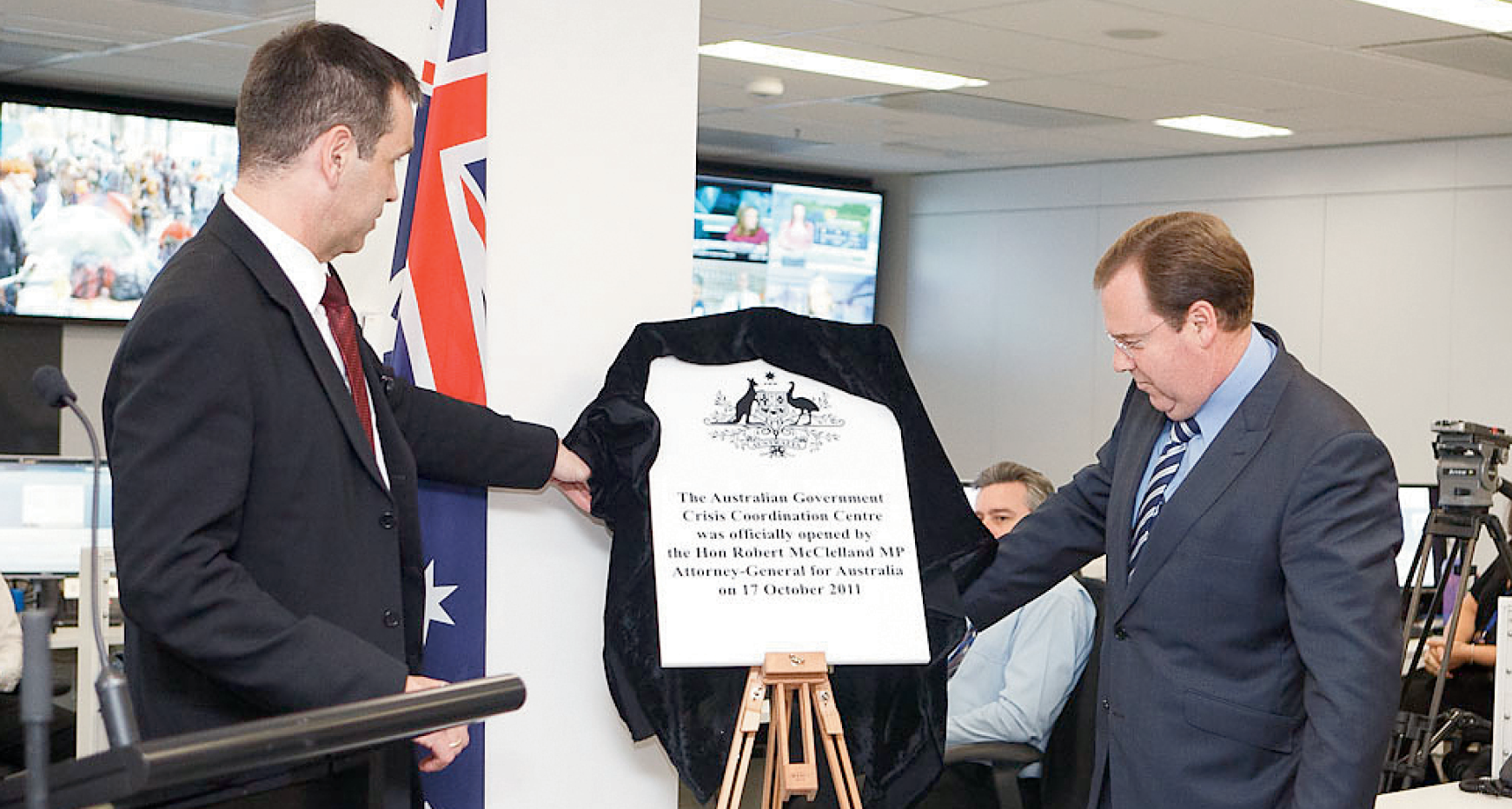
On 17 October 2011, former Attorney-General, the Honourable Robert McClelland, (now Minister of Emergency Management) officially opened the Australian Government Crisis Coordination Centre (CCC).

The Hon Robert McClelland MP opening the Crisis Coordination Centre on 17 October, 2011.
The CCC is part of the National Crisis Coordination Capability Program (NCCCP). The NCCCP was established in 2008 after the completion of the Homeland and Broader Security Review. The Review recommended a need to centralise information and coordination to improve the way the Prime Minister and Cabinet are briefed during a crisis,
The Review recommended the establishment of:
The Prime Minister’s National Security Statement (4 December 2008) confirmed the Government’s intent to move to an all hazard approach to crisis coordination.
An all hazards approach, as defined in the Australian Emergency Management Glossary refers to all types of emergencies or disasters and civil defence using the same set of management arrangements.
As outlined in the Australian Government Crisis Management Framework, the Crisis Centre Manager has responsibility for the overall management of the CCC. This role is filled by the Director-General of Emergency Management Australia.
In August 2009, work commenced on the development of the CCC Concept of Operations. This included research and analysis of current work practices and aligning new work strategies to the recommendations outlined in the Review.
The CCC Concept of Operations describes the high level functions and processes undertaken within the CCC. The four main functions of the CCC are Situational Awareness, Intelligence, Planning and Public Communication.
Campbell Darby, Director General of Emergency Management Australia, says “the central CCC concept is whole of government coordination. There have been a number of complexities in determining the detail on how the concept would be put into practice. Having a state of the art facility designed to fit the concept has been of great benefit in transitioning to these new arrangements”.
“As with any major program, there was a lot of ground work to be done including the development of the new policy proposals and the business case. Once Government approved the concept, the real work began. There were a number of complex activities from designing business processes and assessing requirements to procurement and contracts for demolition, construction, Information Communications Technologies (ICT), secure video teleconferencing (SVTC) and Audio Visual” said Mark Carpenter, Assistant Secretary Crisis Support Branch of Emergency Management Australia.
The design process for the CCC, accommodated in the Edmund Barton Building commenced in July 2009, initially focusing on the spaces shared with the Australian Federal Police. Design work for the CCC spaces began in earnest in February 2010. A design consultative forum was established and brought together the architects, CCC staff representatives and other areas within the Attorney-General’s Department. The consultative forum provided an opportunity to workshop ideas for how the space could support the work of the CCC while meeting building codes and security requirements.
By April 2010, there was an approved sketch plan for the CCC space.
Another six months of detailed design work by the architects, engineers and security consultants was required to complete the documentation required for construction. Demolition work in the CCC space began in December 2010 and fit out commenced in January 2011. The fit out of the facility was completed in July 2011 and was followed by two months of Information Communication Technologies (ICT) and Audio Visual installation, rigorous testing and training.
Thorough external agency consultation occurred throughout all phases of the CCC project. External agencies provided input into key concept documentation including the CCC Concept of Operations and other methodologies. Regular stakeholder meetings were undertaken to discuss the implications of the changes being made and the impacts of that these changes would bring.
The CCC has been designed to connect relevant Australian Government, State and Territory agencies to centralise Australian Government actions during complex national crises, to develop a single, timely and consistent picture or understanding of a crisis, its implications and the national capacity to respond.
The CCC is capable of supporting whole-of-government coordination for multiple, concurrent domestic crises and provides support to Department of Foreign Affairs and Trade and AusAID during international incidents.
The CCC is managed by Emergency Management Australia, a division of the Attorney-General's Department (on behalf of the Australian Government) on a 24/7 basis.
“The new CCC facility has greatly enhanced the way CCC Operations does its work” said Emma Appleton, Director of CCC Operations.
“We now work very closely with the Planning and Public Communications functions on a daily basis, and when necessary we will also be able to work with staff carrying out the intelligence function. The new facility also has plenty of room for Liaison Officers from Australian Government agencies and the jurisdictions to work with us when necessary.” Ms Appleton says.
Key features of the CCC include:
“The real test of the CCC will be the 2011-2012 disaster season and future incidents. This will allow all the new capabilities to be tested” said Mr Darby.